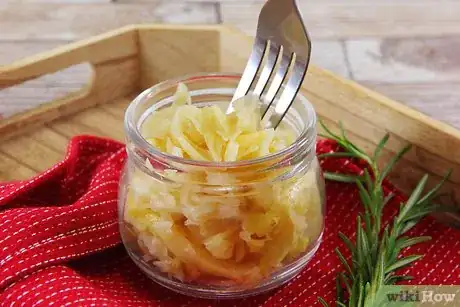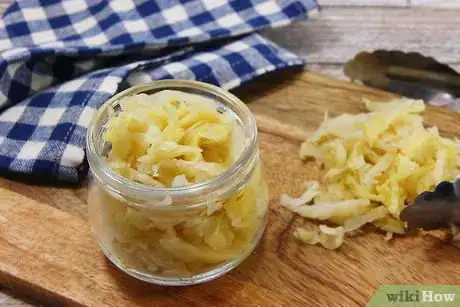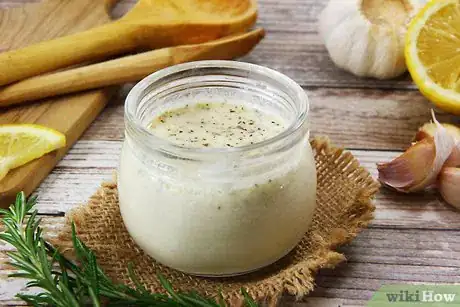This article was co-authored by wikiHow Staff. Our trained team of editors and researchers validate articles for accuracy and comprehensiveness. wikiHow's Content Management Team carefully monitors the work from our editorial staff to ensure that each article is backed by trusted research and meets our high quality standards.
This article has been viewed 55,170 times.
Learn more...
Sauerkraut literally translates to ‘sour cabbage’ in German, but don’t let the unsavoury translation stop you from adding this fermented nutritional powerhouse into your daily meals. Sauerkraut adds a punchy flavour and good bacteria, antioxidants, fibre, and vitamins to any meal. One serving of unpasteurized and uncooked sauerkraut contains more lactobacillus bacteria than one serving of live yogurt.
Steps
Eating Raw Sauerkraut
-
1Eat it by the forkful. Raw sauerkraut can be enjoyed as is, by the forkful. Just take the jar out of the fridge, grab a fork, and enjoy the health benefits! Eat a forkful once or twice a day straight from the jar.
- Buy unpasteurized sauerkraut from the refrigerator section of your grocery store. Sauerkraut off the shelf will have been pasteurized which kills the helpful bacteria.
-
2Eat it warm or cold. Cold sauerkraut is the best bet to reap all the natural health benefits. Sauerkraut should be kept in the fridge, even if you bought it off the shelf.
- Take the jar out of the fridge early if you want to have your sauerkraut at room temperature with your meal.
Advertisement -
3Use it as a condiment. For many people, the only way they’ve encountered sauerkraut as a food option is as a condiment for street vendor sausages. From a long-standing German and Polish tradition of topping sausages, to ballpark hot dogs, sauerkraut adds a soft, acidic zing to any meal, not just when fatty meats are involved.
- Top your avocado toast with a forkful of sauerkraut or add a thin layer to any sandwich (not just the traditional Reuben), burger, or wrap (let the brine drip off first so your food doesn’t get soggy).
- Top your scrambled eggs with a little sauerkraut in the morning and you’ll feel full longer due to the cabbage’s fibre content.
- Try it as a mac and cheese topper.
-
4Add it to a salad or macro bowl. Bring the flavour and nutritional value up a notch by adding a forkful or two of sauerkraut to a simple salad. Make a simple salad of torn lettuce leaves, olive oil, lemon juice, and black pepper, then top with raw sauerkraut for a green salad with zing.[1]
- Sauerkraut pairs well with everything from shredded apple and carrot to ginger and mango, so be creative.
- The sweetness of apples and carrots perfectly balance the zip of the sauerkraut.
- Add or substitute it in any time you would eat pickles.
Eating Cooked Sauerkraut
-
1Add sauerkraut to soups and stews. Sauerkraut goes well with everything from beef stew to carrot ginger soup. Cooking the sauerkraut into a dish will destroy the helpful bacteria. If you’re eating sauerkraut for the live bacteria, stir a forkful into your soup or stew just before you eat it instead.
- Make a potato bacon soup, then add a cup or two of sauerkraut, let it simmer for another 30 minutes, and serve.
-
2Bake sauerkraut into a casserole or pasta. Sauerkraut naturally pairs well with pork, so try a casserole of sausage, mushrooms, and sauerkraut.
- Baking sauerkraut into your meal can potentially help with digestion.
- Make a Polish casserole of pasta noodles, sauerkraut, Swiss cheese and sausages.[2]
- Add sauerkraut to your meatball mixture before cooking them or toss it into your pasta sauce.
- Fry it up in a skillet with sausage, potatoes, and onion.
-
3Bake sauerkraut into a chocolate cake! Add ¾ cup of sauerkraut to your chocolate cake for an adventurous twist.[3]
Blending Sauerkraut
-
1Blend some of the brine into a smoothie. You can reap some of the benefits of sauerkraut and get accustomed to its unique taste by using just the brine. Start with a spoonful of brine before adding sauerkraut.
-
2Blend sauerkraut into a smoothie. Stir 1-2 tablespoons of sauerkraut into your favourite green smoothie before blending.
- Try it with kiwi and kale. Add in some iceberg lettuce and orange to complete the smoothie.[4]
- Try a green smoothie made of 1 cup of kefir, ½ cup of sauerkraut, 1 tbsp dill green apple, and 3 cups of dandelion greens.[5]
- Go beyond green smoothies with a chocolate avocado sauerkraut smoothie. Blend half a frozen banana, half an avocado, 2 tbsp sauerkraut, 3 tbsp cocoa, 2 tbsp flax or chia, 1 tsp honey, ½ tsp cinnamon, 1 cup of water, and ¼ cup almond milk.
-
3Blend the leftover brine into a salad dressing. Reuse the nearly empty container by simply blending the leftover juice with olive oil, white wine vinegar, dijon mustard, and lemon juice and zest. Pour back into your empty container and keep in the fridge.[6]
Community Q&A
-
QuestionCan sauerkraut be too sour?
 Community AnswerYes. If you find yours to be too sour, try adding a little sugar or half of a diced apple.
Community AnswerYes. If you find yours to be too sour, try adding a little sugar or half of a diced apple.
Warnings
- When in doubt, discuss your dietary needs with a doctor or registered dietician.⧼thumbs_response⧽
- Keep an eye on your salt intake, as sauerkraut is high in salt from the fermentation process.⧼thumbs_response⧽
References
- ↑ https://www.makesauerkraut.com/easy-ways-to-eat-sauerkraut/
- ↑ https://www.tasteofhome.com/recipes/polish-casserole/
- ↑ https://www.tasteofhome.com/recipes/sauerkraut-chocolate-cake/
- ↑ https://wholesome-cook.com/2012/01/27/5-things-to-make-with-sauerkraut-other-than-a-reuben/
- ↑ https://monamifood.wordpress.com/2015/06/27/dandelion-greens-sauerkraut-dill-kefir-make-a-great-smoothie/
- ↑ https://www.wellandgood.com/good-food/how-to-use-sauerkraut/slide/6/

































































